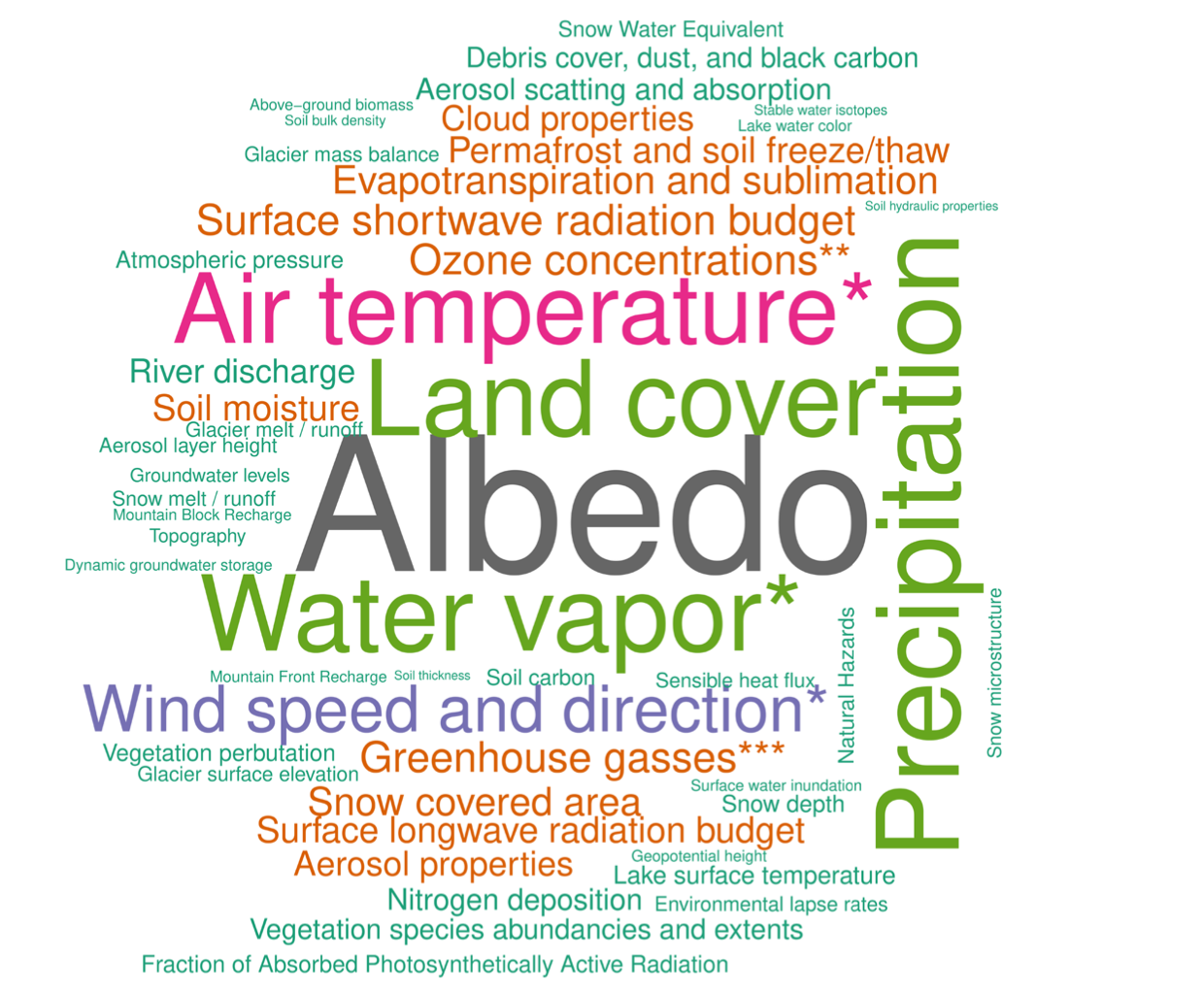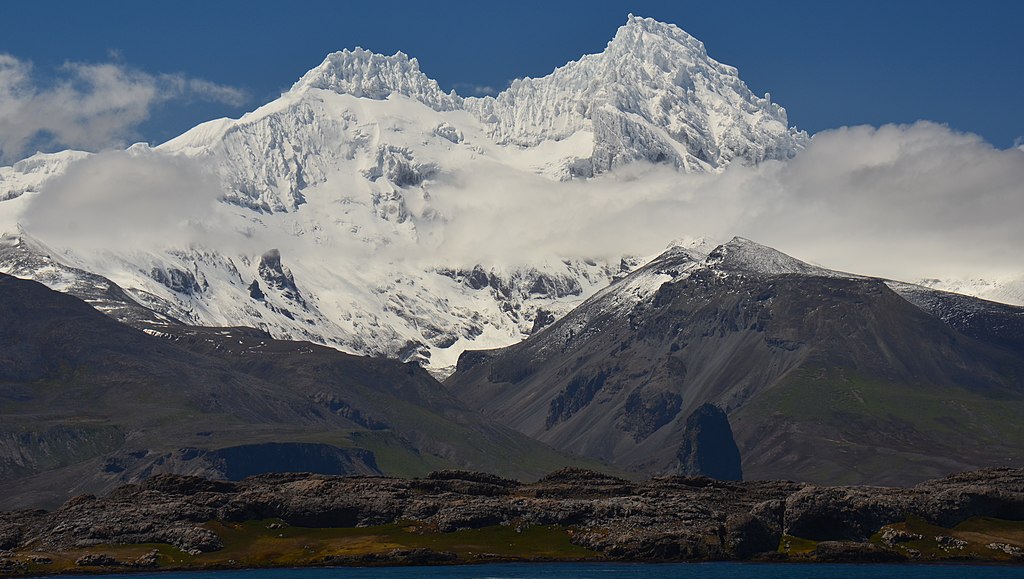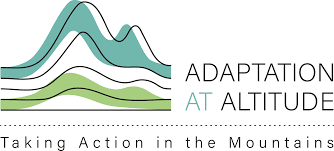A new article published in the journal One Earth proposes a set of potential Essential Mountain Climate Variables to support the monitoring and understanding of key climate change-related mountain processes. The article builds upon a workshop organized by GEO Mountains and hosted by the MRI.
Climate change is having a range of effects on mountain environments and the critically important ecosystems services they provide. Decision-makers rely on the mountain research community to monitor, understand, and predict possible future changes in these complex, interacting processes. For instance, global assessments, local and regional climate modeling, and climate change adaptation and mitigation all require consistent, long-term, and inter-comparable environmental observations.
Challenges of environmental monitoring in mountains
Despite many recent advances, remote sensing is not a panacea; for example, the spatial resolution of many products remains too coarse to capture the effects of complex mountain topography, while clouds continue to complicate optical efforts. Perhaps more importantly, many variables of potential interest cannot be measured remotely. In situ data therefore remains a crucial component of wider observation strategies. However, access difficulties, inhospitable conditions, and limited funding/technical capabilities often constrain the quantity and representativeness of in situ data that can be obtained and/or shared in such environments.
A globally intercomparable baseline of evidence related to mountain environmental change requires establishing an interdisciplinary set of variables on which to focus our limited resources; specifying associated minimum observation requirements; and thinking creatively about how to combine remotely sensed data, in situ data, and numerical models to leverage their respective benefits while mitigating their limitations.
“The lack of interdisciplinary consensus regarding which variables should be measurement priorities in mountain environments, and their associated observation requirements, has given rise to an extremely heterogenous data landscape, which is impeding both fundamental science and more practical applications," explains lead author James Thornton, MRI Scientific Project Officer for GEO Mountains. “To address this, in our article we propose the concept of Essential Mountain Climate Variables (EMCVs) and outline some initial steps that have already been taken towards its establishment."
Following an interdisciplinary review of the main climate change processes in mountain environments and their interactions, 97 associated potential EMCVs are identified and ranked according to perceived importance. The article goes on to summarize established and emerging possibilities to measure, formalize, and apply EMCVs. "We took the view that EMCVs do not necessarily have to be routinely measurable today using standard technologies. Rather, the final set of EMCVs may ultimately constitute an optimistic 'wish list,' driven by the requirements of data users, that could stimulate the development of new methods and technologies. We are also extremely excited by the growing potential to blend data and numerical models to derive spatially and temporally complete, consistent EMCV datasets that exploit the information content of the underlying data as fully as possible," adds Thornton.
Bringing the community together
Thornton and others' list of potential EMCVs was developed from discussions held during a 2019 workshop entitled Essential Climate Variables for Observations in Mountains, organized under the auspices of GEO Mountains and hosted by the MRI. The variables considered to be at least somewhat important for monitoring and understanding key climate change-related mountain processes are depicted in the word cloud pictured below.

Word cloud developed from the ranked set of Essential Mountain Climate Variables (EMVCs). Word size reflects the consensus ranking. Asterisks denote classes of variables that were combined to produce the figure (Thornton et al., 2021).
Interesting themes emerge from this ranking of perceived importance. Many higher-ranked (more important) variables, such as albedo and land cover, correspond to multiple components of the Earth system (e.g., atmosphere, biosphere, cryosphere, hydrosphere). These 'sphere-linking' variables represent critical data requirements that strictly disciplinary approaches may overlook. In contrast, lower-ranking variables relate to specific components of individual spheres, such as soils, rivers, lakes, and forests. Interestingly, several of the potential EMCVs are not among the globally relevant Essential Climate Variables (ECVs) curated by the Global Climate Observing System (GCOS), justifying the paper's mountain-specific approach.
Future directions
Thornton and others intend for their contribution to act as a starting point from which the mountain research community can agree on a more formalised set of EMCVs and the associated requirements that each variable must possess (spatial resolution, frequency, etc.) in order to be useful for general applications. This should then enable assessment of the extent to which EMCV requirements can be met using existing data sources. Finally, the community can work towards 'filling the gaps,' which will likely include extending existing or establishing new long-term in situ observatories and exploiting high-resolution satellite-based Earth observation data products.
The MRI's Elevation-Dependent Climate Change and Mountain Observatories Working Groups contributed to the workshop and study.
The authors would like to express their thanks to the ESA-Future Earth Joint Program for funding and support.
READ MORE: Thornton, J.M., Palazzi, E., Pepin, N.C., Cristofanelli, P., Essery, R., Kotlarski, S., Giuliani, G., Guigoz, Y., Kulonen, A., Pritchard, D., Li, X., Fowler, H.J., Randin, C.F., Shahgedanova, M., Steinbacher, M., Zebisch, M., and Adler, C. (2021). Toward a definition of Essential Mountain Climate Variables. One Earth. doi: 10.1016/j.oneear.2021.05.005
Cover image by Cousin jf, CC BY-SA 4.0, via Wikimedia Commons.









